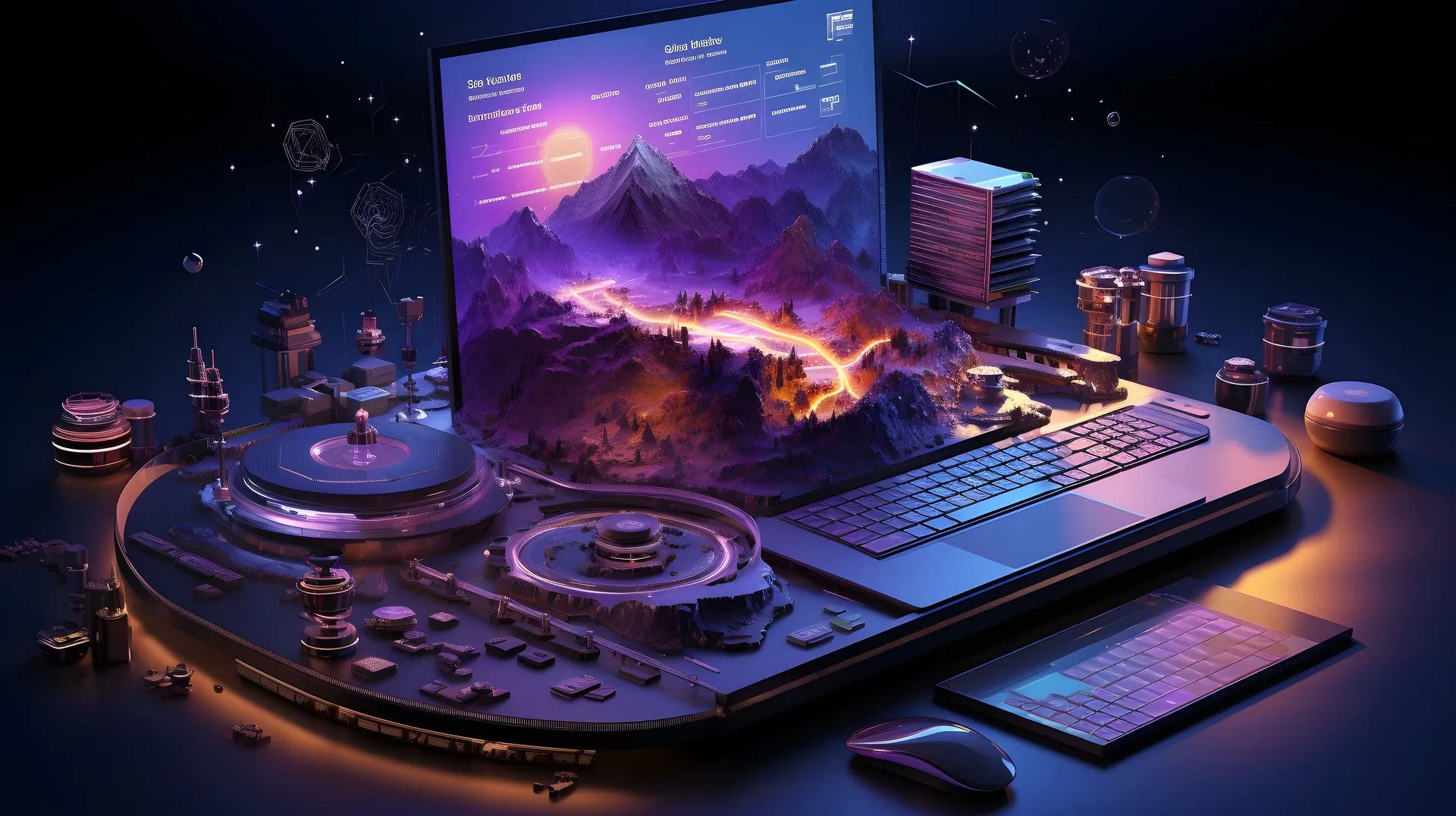The digital world in 2025 asks for much more than just a passive website. It needs a resilient, scalable, and secure web application. This is the true engine of modern business. A web app delivers interactive, dynamic features. Think: Create, Read, Update, Delete, or CRUD. These features truly separate it from a static web page. It lets users manage accounts and process transactions. It also handles complex data. Web app development is the core of digital transformation today.
Historically, the internet was only static content. Then, technologies like Ajax changed everything. This made user experiences richer and more interactive. Today, making web apps isn’t optional; it’s essential. This guide gives you the strategic clarity you need. It covers technology, budget, and partnership. It will help you navigate the entire web app development process. You can easily outperform the competition.
What Is Web App Development?
Web app development is the process of developing apps that work in a browser instead of being installed. They enable users to work together, perform tasks, and handle data in real time.
Web apps differ from static web pages because they are dynamic and interactive. They enable users to input complex processes. A few examples of widely used web apps are:
Google Docs: An in-cloud collaborative document editor in real-time.
Trello: A project management software that structures teams.
Slack: An office messenger app.
Web application development services provide a seamless experience across different devices. Thus, they are used by companies that are looking to reach a huge audience base. They help companies by resolving the issue of creating individual programs.
Understanding Web App Development Structure and Architecture
What exactly is a web application? It’s software that runs on a remote server. Users access it using a web browser. That’s what makes it different from a desktop program.
| Feature | Website | Web Application |
| Interactivity | Minimal; just serves up content. | Highly interactive; takes user input and processes data. |
| Function | Informational, like a company brochure. | Functional, dynamic, workflow-based (e.g., SaaS). |
| User Login | Generally, none needed. | Requires user authentication and personalized data. |
Most web apps rely on the classic 3-Tier Architecture:
- Presentation Layer (Frontend): This is the user interface (UI). It’s what your users see and click on. It’s built with HTML, CSS, and JavaScript.
- Application Layer (Business Logic): This is the brain, the server side logic. It processes data and executes core functions.
- Data Layer (Database): This is where all your app’s data lives securely. You’ll use databases like PostgreSQL or MongoDB.
For bigger, enterprise projects, developers use advanced structures. These include Microservices and N-Tier architectures. They are designed for massive scaling and security. Understanding these basics is vital. It’s the first step to successfully create a web application.
Why Build a Web App?
Developers and businesses select web apps for various reasons, such as:
1. Quicker Deployment
They avoid app store approval and don’t need development for iOS and Android, which can be expensive.
2. Cross-Platform Access
Web applications can be accessed on any browser-supported platform. They are as good on desktops, tablets, and even mobile phones.
3. Scalability and Flexibility
New technologies such as React, Angular, and Vue.js enable developers to build scalable applications. These new technologies evolve with increasing business demands.
4. AI and Automation Integration
AI-driven web applications are no longer the norm. Companies use AI for predictive analytics, chatbots, and personalized recommendations.
Top Web Application Development Trends in 2025
The future of web app development is in technological advancements. These are the top trends to follow in 2025:
1. Progressive Web Apps (PWAs)
PWAs enjoy the best aspects of websites and native apps. They have high loading speeds, are offline, and push notifications.
Use Case: Spotify PWA sped up the loading process by 70% with an enhanced user experience.
2. AI-Powered Personalization
AI-driven web applications track the user’s behavior and give them personalized experiences.
Example: Netflix employs AI-driven recommendations to keep the user interested.
3. Low-Code/No-Code Platforms
Bubble, Webflow, and Budibase enable organizations to develop web applications with little coding. This is helping startups develop apps quickly and at lower costs.
4. Cloud-Native Development
Web apps are now created on cloud platforms such as AWS, Google Cloud, and Azure to make them scalable and secure.
5. Zero Trust Security Models
In response to increasing cyber attacks, web applications embrace many features. These are zero-trust security models, multi-factor authentication, and biometric identification.
Choosing Your Technology: The Right Stack for Your Strategy
Choosing your tech stack isn’t just a technical decision. It’s a strategic one. It must align with goals like speed, cost, and scalability. This choice impacts future app development.
Popular Full-Stack Ecosystems (The Practical Choices):
- MERN/MEAN (JavaScript Ecosystem): This stack is amazing for rapid web app development. It excels at single page application interfaces.
- Python (Django/Flask): Python frameworks are powerful. They are excellent for data science projects. Django and Flask are robust backend choices.
- LAMP/LEMP (PHP/MySQL): This traditional stack is known for its stability. It’s still reliable for large legacy systems.
Modern Architecture Deep Dive (Current Trends):
- Progressive Web Apps (PWAs): These apps feel like native mobile apps. They run right in a browser. They are fast, reliable, and work offline. This is a huge advantage.
- Cloud-Native & Zero Trust Security: Security isn’t an afterthought anymore. This approach builds security right into the architecture. Platforms like AWS, Azure, or GCP are used. This ensures long term viability.
- Low-Code/No-Code Platforms: Tools like Bubble let you make web app incredibly fast. You are trading speed for deep customization, however. It also limits security hardening. Consider that trade-off carefully.
The End-to-End Web App Development Process (The Quality Factor)
Following a professional web app development process is key. It guarantees quality and controls your budget. It also future-proofs your product. This is crucial for any serious building web solution.
Discovery, Planning, and Prototyping: This phase defines the product. It includes features, user stories, and wireframes. Clear plans prevent disaster later.
Development and Implementation: This is the core coding phase. We use Agile sprints for fast, iterative improvements. This ensures continuous delivery.
Comprehensive Quality Assurance (QA) Process: This is the critical piece that amateur teams often skip. Good QA prevents expensive post-launch fixes.
- Unit Testing vs. Integration Testing: Unit tests check small pieces of code. Integration tests ensure all APIs talk to each other reliably.
- User Acceptance Testing (UAT): This is the final sign-off. End-users confirm the web app meets all business needs.
- Load and Performance Testing: These tests simulate peak traffic. They guarantee system stability. We measure metrics like Core Web Vitals. The commitment to quality defines website and app development.
Deployment & Monitoring: The app is finally launched. We automate the process using CI/CD pipelines. Tools like Docker and Kubernetes ensure smooth updates.
Cost, Monetization, and Partnership
The True Cost of Web App Development
When budgeting, look at the full lifecycle. Don’t just focus on initial coding. The cost to develop web app varies significantly.
| App Complexity | Approximate Development Cost | Key Cost Drivers |
| Minimum Viable Product (MVP) | Moderate ($15,000−$45,000+) | Focus on core features, speed, and basic hosting. |
| Mid-Size/Custom | High ($45,000−$120,000+) | Full features, custom web application development services, API integrations, and comprehensive QA. |
| Enterprise/Complex | Very High ($120,000−$500,000+) | Microservices, advanced security, long term maintenance, and complex application logic. |
Don’t forget the Hidden Costs: You must budget for hosting fees. Also, budget for SaaS service licenses. And don’t forget mandatory post-launch maintenance.
Monetization Models for Your Web App
How is your web app going to make money? This model is key to its design.
- SaaS Subscription: Users pay a recurring fee to use your tool. This is the industry standard.
- Transactional Models: Users pay per purchase or transaction. This is common for marketplaces.
- Freemium and Ad-Supported: Offer basic features free. Then charge for premium upgrades.
Choosing Your Development Partner
Choosing a web app development partner is critical. It determines your project’s success.
| Partner Type | Pros | Cons (Risk Factors) |
| Freelancer | Low upfront cost, high flexibility for small tasks. | Limited scale, high risk of turnover, little formal QA. |
| In-House Team | High control, great cultural fit. | Very high salary overhead, high long-term operational cost. |
| Expert Agency (DevSphere Technologies) | Fixed Timeline, Integrated QA, Scalability, Full-Stack Expertise. | Higher initial investment, but dramatically lower long-term risk. |
DevSphere Technologies offers the managed, end-to-end expertise you need. We ensure your app is built correctly. It will be secure and scalable. This expertise is vital for developing a web application that truly succeeds.
Conclusion
Successful web app development in 2025 requires three things. You need current technology and rigorous QA. You also need a smart partnership. Trying to handle a complex application with a fragmented team leads to budget overruns. It often results in an unstable product. For high-stakes projects, expertise is essential.
Don’t risk your vision on short-term solutions. Partner with the experts. We manage the full lifecycle, from concept to launch.
Ready to build a scalable web application with confidence?
Contact Us Today for Your Web App Development Services.
FAQs
What are web app development services?
Web app development services are the professional processes used. They design, build, test, and maintain software applications. These are accessible through a web browser. They cover everything from UX to the backend logic.
Which services do you offer for web application development?
DevSphere Technologies offers a comprehensive suite of services. These include: Strategic Consulting and IT Consulting, UI Designs and Prototyping, Full-Stack Custom Web Application Development Services, API Development and Integration, Quality Assurance (QA) and Testing, Cloud Deployment, and Ongoing Support.
Which is the best web development agency?
The “best” web development agency depends on your project’s needs. The top partners prioritize a discovery phase. They offer transparent pricing. They employ full-stack expertise. They commit to extensive QA and support, like DevSphere Technologies.
What are custom web application development services?
Custom web application development services mean building software tailored exactly to your processes. It’s the opposite of off-the-shelf software. It ensures zero wasted features. It provides complete control over future updates.
How long would it take to develop a web browser?
Developing a web browser is a multi-year undertaking. It requires a huge team and 3+ years for the core engine. It’s fundamentally different from developing web app.




